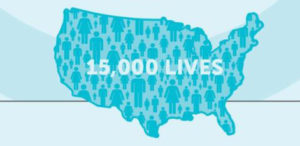 Smoking rates in North Carolina are not declining as steadily as in much of the rest of the country. According to the American Lung Association, North Carolina significantly lags behind other states with respect to availability of programs to prevent smoking, support those who want to quit and treat those who have health issues directly related to smoking.
Smoking rates in North Carolina are not declining as steadily as in much of the rest of the country. According to the American Lung Association, North Carolina significantly lags behind other states with respect to availability of programs to prevent smoking, support those who want to quit and treat those who have health issues directly related to smoking.
Lung cancer remains the leading cause of cancer deaths in the United States. The most effective way to decrease your risk of developing lung cancer is to stay away from cigarettes or, if you already smoke, to quit.
A second way to combat lung cancer is to take part in effective screening strategies. Early detection can give lung cancer patients greater access to treatments. Low-dose CT lung cancer screenings give doctors and patients the ability to detect lung cancer when it’s potentially curable. Data shows that people with significant smoking history have higher rates of death from lung cancer, and the risk persists for many years after quitting.
Who Should Consider Low-Dose CT Lung Cancer Screening?
CT lung cancer screenings have proven so effective in early cancer detection that in March 2021 the United States Preventative Services Task Force expanded eligibility criteria for who should have a CT lung cancer screening. After talking with your doctor, be sure to check with your insurance carrier to see if you qualify under current or new guidelines. Our team is closely following this change in CT lung cancer screening recommendations.
What is a CT Lung Cancer Screening?
Low-dose dose chest CT scan is an imaging test proven to identify and decrease the risk of dying from lung cancer in high risk patients. At WakeRad UNC REX, we are sensitive to the amount of radiation used during any CT procedure and optimize our technology to accurately obtain the best quality images at the lowest possible radiation dose. The x-ray radiation involved in a lung cancer screening is 4-5 times less than what’s involved in a diagnostic CT and is lower than the average background radiation you experience throughout the course of a year.
Why should you be screened?
During a large study called the National Lung Cancer Screening Trial (NLCST), people at high risk for lung cancer (the criteria listed above) and who underwent annual, low-dose chest CT scans were 20% less likely to die from lung cancer than high-risk individuals who were screened with only a chest x-ray.
How often do you need to be screened?
Both the National Cancer Institute and WakeRad UNC REX recommend that high risk patients be screened once a year.
Are screenings covered by insurance?
When you meet certain criteria, lung cancer screenings are typically covered by Medicare and most major insurance carriers. However, with new guidelines set by the USPSTF in March 2021, Wake Rad UNC REX recommends that patients talk with their healthcare provider and then check with their insurance provider to verify they qualify for this screening.
Where should you be screened?
WakeRad UNC REX is the first outpatient imaging provider in the area to achieve accreditation by the American College of Radiology (ACR) and is designated as a lung cancer screening center. The strict standards of accreditation mean our offices have:
- Up-to-date CT scanners that ensure a low radiation dose is administered.
- Experienced radiologists who interpret chest CT exams. All of our lung cancer screening exams are interpreted by radiologists who subspecialize in body imaging and diagnosing diseases of the chest.
WakeRad UNC REX offers low-dose CT lung cancer screenings at all of its offices throughout the greater Triangle area where CT services are provided.

